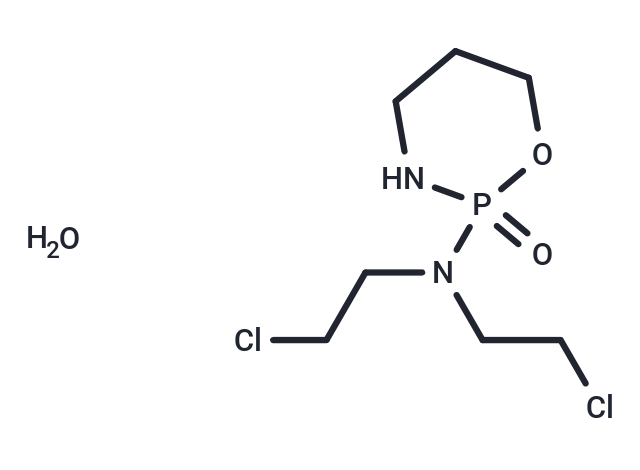Shopping Cart
- Remove All
 Your shopping cart is currently empty
Your shopping cart is currently empty

Cyclophosphamide hydrate is a DNA alkylating agent, an inhibitor of DNA synthesis. Cyclophosphamide hydrate has antitumor and immunosuppressive activities.

| Pack Size | Price | Availability | Quantity |
|---|---|---|---|
| 50 mg | $33 | In Stock | |
| 100 mg | $47 | In Stock | |
| 200 mg | $58 | In Stock | |
| 500 mg | $87 | In Stock | |
| 1 g | $133 | In Stock |
| Description | Cyclophosphamide hydrate is a DNA alkylating agent, an inhibitor of DNA synthesis. Cyclophosphamide hydrate has antitumor and immunosuppressive activities. |
| In vitro | METHODS: Macrophage Raw 264.7 was treated with Cyclophosphamide hydrate (10-250 μg/mL) for 48 h. Cell viability was measured by MTT assay. RESULTS: Cyclophosphamide hydrate was cytotoxic to Raw 264.7 with an IC50 of 145.44 μg/mL. [1] METHODS: Human breast cancer cells MDA-MB-231 and MDA-MB-435S were treated with Cyclophosphamide hydrate (0.25-1 mM) for 4-24 h, and cell migration was detected by Wound healing assay. RESULTS: The increase in the number of migrating MDA-MB-231 cells was dependent on the concentration of Cyclophosphamide, while migration to MDA-MB-435S cells was significantly reduced and independent of Cyclophosphamide concentration. [2] |
| In vivo | METHODS: To test the antitumor activity in vivo, Cyclophosphamide hydrate (50-150 mg/kg) was administered as a single intraperitoneal injection to BALB/c mice bearing mouse colorectal tumor CT26. RESULTS: Cyclophosphamide hydrate induced a significant reduction in tumor volume. [3] METHODS: Cyclophosphamide hydrate (140 mg/kg) was administered orally to Balb/c mice bearing mouse mammary carcinoma tumor 4T1 every six days for eighteen days to determine the antitumor activity in vivo. RESULTS: Cyclophosphamide hydrate treatment significantly inhibited tumor growth in mice. [4] |
| Kinase Assay | 9L cells are treated with drug for the times indicated in each experiment. Floating and attached cells are collected, pooled, resuspended in lysis buffer (10 mM HEPES buffer, pH 7.4, containing 2 mM EDTA, 0.1% CHAPS detergent, 5 mM DTT, 350 ng/mL phenylmethylsulfonyl fluoride, 10 ng/mL pepstatin A, 10 ng/mL aprotinin, and 20 ng/mL leupeptin) and lysed by three freeze-thaw cycles (alternating between a dry ice isopropanol bath and a 37°C water bath). Lysates are spun in a bench top centrifuge at full speed for 15 min and the supernatant (cell extract) fraction transferred to a new tube. Cell extracts (20 μL) are assayed for caspase 9, caspase 8, and caspase 3 activity by incubation at 37°C for either 1 h (caspase 3) or 3 h (caspase 9 and caspase 8) in 500 μL of reaction buffer (10 mM HEPES, pH 7.4, 2 mM EDTA, 0.1% CHAPS, and 5 mM DTT) containing 50 μM caspase form-selective substrate: Ac-LETD-AFC for caspase 8; Ac-LEHD-AFC for caspase 9; and Ac-DEVD-AMC for caspase 3. Background activity is determined for each sample as follows. Cell extracts are preincubated for 15 min at room temperature, with or without caspase form-selective inhibitor: 1 μM z-LETD-FMK for caspase 8, 1 μM z-LEHD-FMK for caspase 9, and 5 μL of Casputin for caspase 3. Caspase activity measured in the absence of inhibitor is divided by the background caspase activity measured in the presence of inhibitor. A value of 1 is subtracted from each measured activity, such that a caspase activity of 0 corresponds to no increase in the specific caspase activity with drug treatment. Fluorescence of the caspase product (excitation at 395 nm and emission at 525 nm for AFC substrates, and excitation at 380 nm and emission at 460 nm for the AMC substrate) is measured using a Shimadzu model RF-1501 spectrofluorophotometer and the manufacturer's PC-1501 software package. |
| Cell Research | 9L/pBabe, 9L/Bax, and 9L/Bcl-2 cells are treated with 12, 24, or 50 μM MFA for 72 h. Cells remaining on the plates at 0, 24, 48, and 72 h are washed twice with cold PBS and then stained for 5 min with crystal violet [1.25 g of crystal violet dissolved in a solution containing 50 mL of 37% formaldehyde and 450 mL of methanol]. The stained cells are washed three times in tap water and the plates are allowed to dry. The stain is eluted from the cells with 70% ethanol and the absorbance is then read at 595 nm. The staining intensity of each drug-treated sample (A?595) is then graphed as a percentage of the staining intensity at the 0-h time point. |
| Alias | Cyclophosphamide monohydrate |
| Molecular Weight | 279.1 |
| Formula | C7H17Cl2N2O2P·H2O |
| Cas No. | 6055-19-2 |
| Smiles | O.ClCCN(CCCl)P1(=O)NCCCO1 |
| Relative Density. | no data available |
| Storage | Powder: -20°C for 3 years | Shipping with blue ice. | ||||||||||||||||||||||||||||||||||||||||
| Solubility Information | DMSO: 50 mg/mL (179.15 mM), The compound is unstable in solution. Please use soon. H2O: 7 mg/mL (25.08 mM), Sonication is recommended. Ethanol: < 1 mg/mL (insoluble or slightly soluble) | ||||||||||||||||||||||||||||||||||||||||
Solution Preparation Table | |||||||||||||||||||||||||||||||||||||||||
H2O/DMSO
DMSO
| |||||||||||||||||||||||||||||||||||||||||

Copyright © 2015-2025 TargetMol Chemicals Inc. All Rights Reserved.